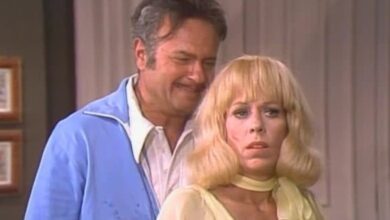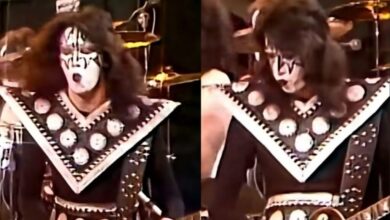Dio’s ‘Rainbow in the Dark’ Ignites London’s Hammersmith Apollo and Reinforces Metal’s Enduring Soul in 1993
On December 12, 1993, Ronnie James Dio stood on the stage of London’s legendary Hammersmith Apollo, bathed in deep crimson lights, flanked by thunderous guitars and towering stacks of amps. The crowd was already reverent before a single note rang out, but when the unmistakable opening synth line of “Rainbow in the Dark” pierced the venue’s heavy air, the atmosphere transformed. First released a decade earlier in 1983, the song had grown into a metal anthem—one that had transcended its era to become a battle cry for those who felt lost, different, or diminished. This live performance, captured in Dio’s Inferno: Last in Live album, did more than revisit a classic; it reaffirmed the song’s timelessness and Dio’s enduring power in an evolving metal landscape.
By 1993, Ronnie James Dio was no stranger to reinvention. Born in 1942 in Portsmouth, New Hampshire, as Ronald James Padavona, he had already fronted three major rock institutions—Rainbow, Black Sabbath, and his own band, Dio. Each chapter had added to his legacy, but it was his solo work that gave him full creative command. Dio was never just a singer; he was a storyteller. With a voice that moved between thunderous growls and operatic wails, and lyrics that evoked swords, shadows, and celestial wars, he carved out a lyrical world that few others dared attempt. His music didn’t just entertain—it transported.
The origins of “Rainbow in the Dark” tell a tale of internal struggle and artistic assertion. Written shortly after his departure from Black Sabbath, the song was co-penned with guitarist Vivian Campbell, bassist Jimmy Bain, and drummer Vinny Appice. At first, Dio doubted the track—its shimmering keyboard riff felt too pop-leaning for his tastes. He famously argued against its inclusion, fearing it diluted the heaviness he sought. But his bandmates pushed back, convinced that its unique blend of melody and power could widen their reach. Thankfully, they prevailed. The track became an anthem not despite its melodic leanings, but because of them—a metal song that felt unashamedly emotional.
The studio version, recorded at Sound City Studios in Los Angeles and produced by Dio and Angelo Arcuri, introduced a striking formula. A swirling keyboard motif opened the track, soon met by Campbell’s crunching guitar and Dio’s searing vocals. What made the song stand out was its structure—while most metal of the time leaned into complex arrangements or speed, “Rainbow in the Dark” embraced immediacy. The verses told of isolation and despair, but the chorus soared, triumphant and defiant. Live in London a decade later, these dynamics hit even harder, charged by the emotional weight of time and the energy of an audience that had grown with the music.
Upon its original release, “Rainbow in the Dark” climbed the Billboard Mainstream Rock Tracks chart and received heavy airplay on MTV, thanks in part to a memorable video shot in the neon-lit streets of London’s Soho. In an age where metal videos often embraced leather and fire, Dio’s urban setting and lone-wolf imagery felt grounded and human. Fans across both sides of the Atlantic embraced the song, propelling the Holy Diver album to commercial and critical success. The live resurgence of the track in 1993 only further solidified its staying power—proving it could still move a crowd after a decade of metal’s transformations.
But “Rainbow in the Dark” did more than top charts—it changed perceptions. It challenged the rigid boundaries that often defined metal, offering vulnerability in a genre that frequently masked it with bravado. In Dio’s hands, the themes of alienation and longing weren’t weaknesses—they were battle scars worn proudly. His London performance brought that ethos to life, showing a crowd of thousands that honesty could be as powerful as any riff.
For Dio, the song’s success opened countless doors. It cemented his solo career and gave him the creative freedom to launch ambitious tours and conceptual albums. His performances became more elaborate, blending fantasy and pyrotechnics with raw musical talent. The song’s enduring popularity helped him weather the changing tides of the late ’80s and early ’90s, including the rise of grunge and alternative rock, which rendered many of his contemporaries obsolete. But Dio endured, largely because songs like “Rainbow in the Dark” spoke to something deeper than fashion or trend.
The song’s influence on the genre is undeniable. It helped normalize keyboards in metal—a taboo at the time—and inspired a generation of power metal and symphonic metal artists who blended melody with might. Bands like Nightwish, Stratovarius, and Kamelot have all cited Dio as an influence, and “Rainbow in the Dark” stands as a key example of that blueprint. It also paved the way for more introspective lyrics within the genre, encouraging others to explore the emotional and psychological side of darkness.
Covers of the song have appeared steadily over the years, ranging from faithful renditions by heavy metal traditionalists to stripped-down acoustic takes. Corey Taylor of Slipknot and Stone Sour famously honored the track during a Ronnie James Dio tribute concert, while metalcore bands have offered heavier reinterpretations. Each version, no matter how stylistically different, underscores the track’s core resilience and universality.
The 1993 Hammersmith Apollo concert was particularly symbolic. Taking place in London—a city central to Dio’s musical history through Rainbow and the early days of Holy Diver—the performance felt like a homecoming of sorts. Despite changing lineups, with Tracy G replacing Vivian Campbell, the spirit of the song endured. Dio’s vocals that night carried the weight of experience and memory, giving new shades to lines once written in youthful frustration.
In the decades since, “Rainbow in the Dark” has never faded from rock consciousness. It continues to appear on classic rock and metal playlists, is regularly cited in “best of” metal song lists, and remains a staple of Dio retrospectives. The live performance at Hammersmith has become a touchstone for fans—proof that greatness isn’t bound by time or trend.
The song also contributed to the evolution of concert expectations in metal. With its layered instrumentation and dynamic shifts, it demanded a theatricality and polish that elevated live metal performances. Dio’s use of stagecraft—lasers, dragons, smoke—would later influence bands like Iron Maiden, Ghost, and Rammstein, who pushed those aesthetics even further.
Following Dio’s death in 2010, “Rainbow in the Dark” emerged as one of the defining songs used in memorials and tributes. It was included in numerous posthumous compilations and performed at the “Ronnie James Dio – This Is Your Life” tribute concert. It remains one of the most emotionally resonant tracks in his catalog—a song about being lost, sung by someone who led generations home through music.
To watch Dio command the Hammersmith stage in 1993 was to witness a master in his element. The crowd, many of whom had grown up with the song, knew every lyric, every bend of the guitar solo. Yet even with their familiarity, the song still hit like lightning. It didn’t matter that it was ten years old; it still felt urgent, vital, and deeply human.
“Rainbow in the Dark” is more than just a song—it’s a declaration. In Dio’s hands, both in the studio and on the London stage, it became an anthem for those struggling to find their place. And whether heard for the first time in 1983 or experienced live in 1993, its message remains the same: even in isolation, even when you feel invisible, your fire still burns. And that, perhaps, is the truest legacy of Ronnie James Dio.





